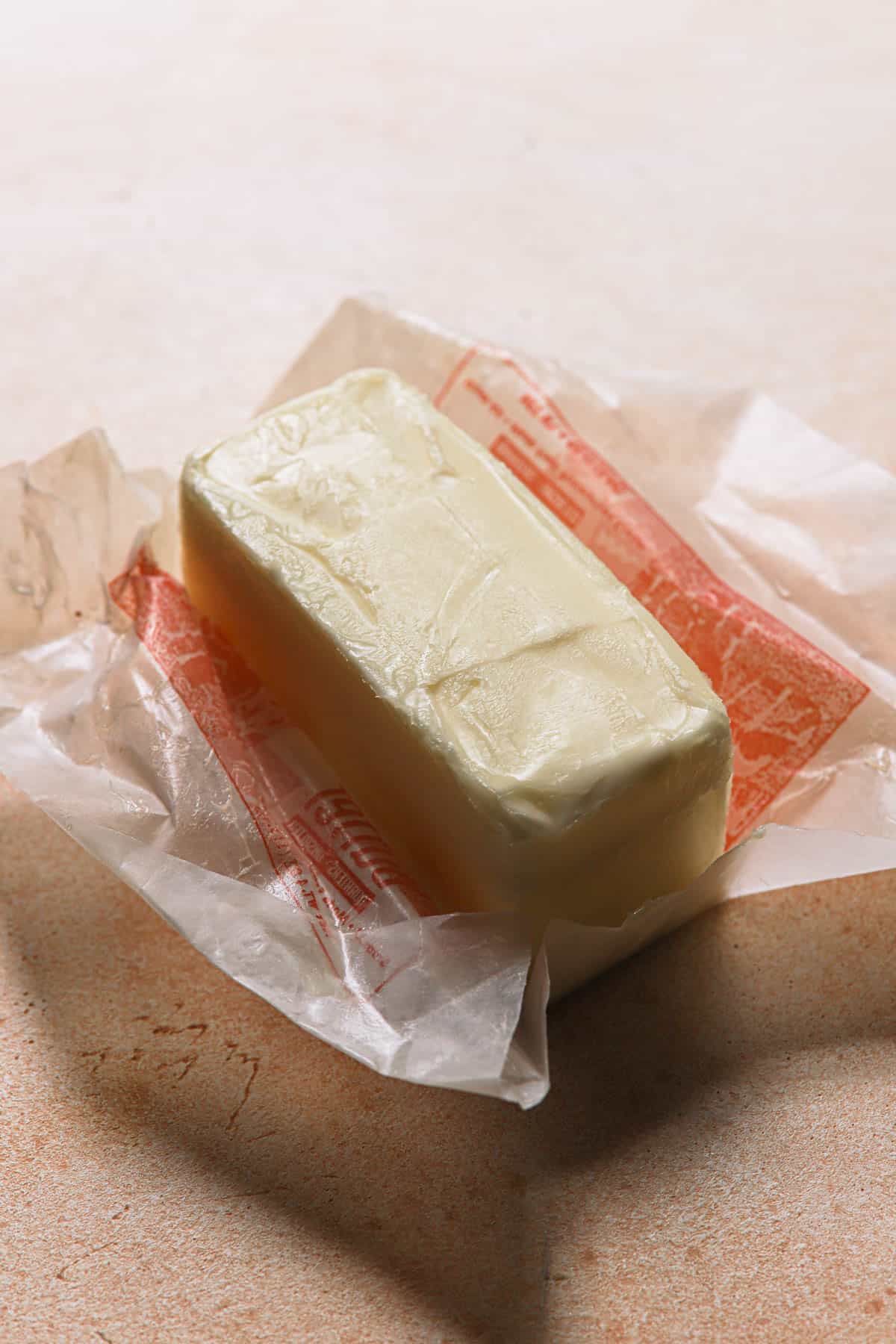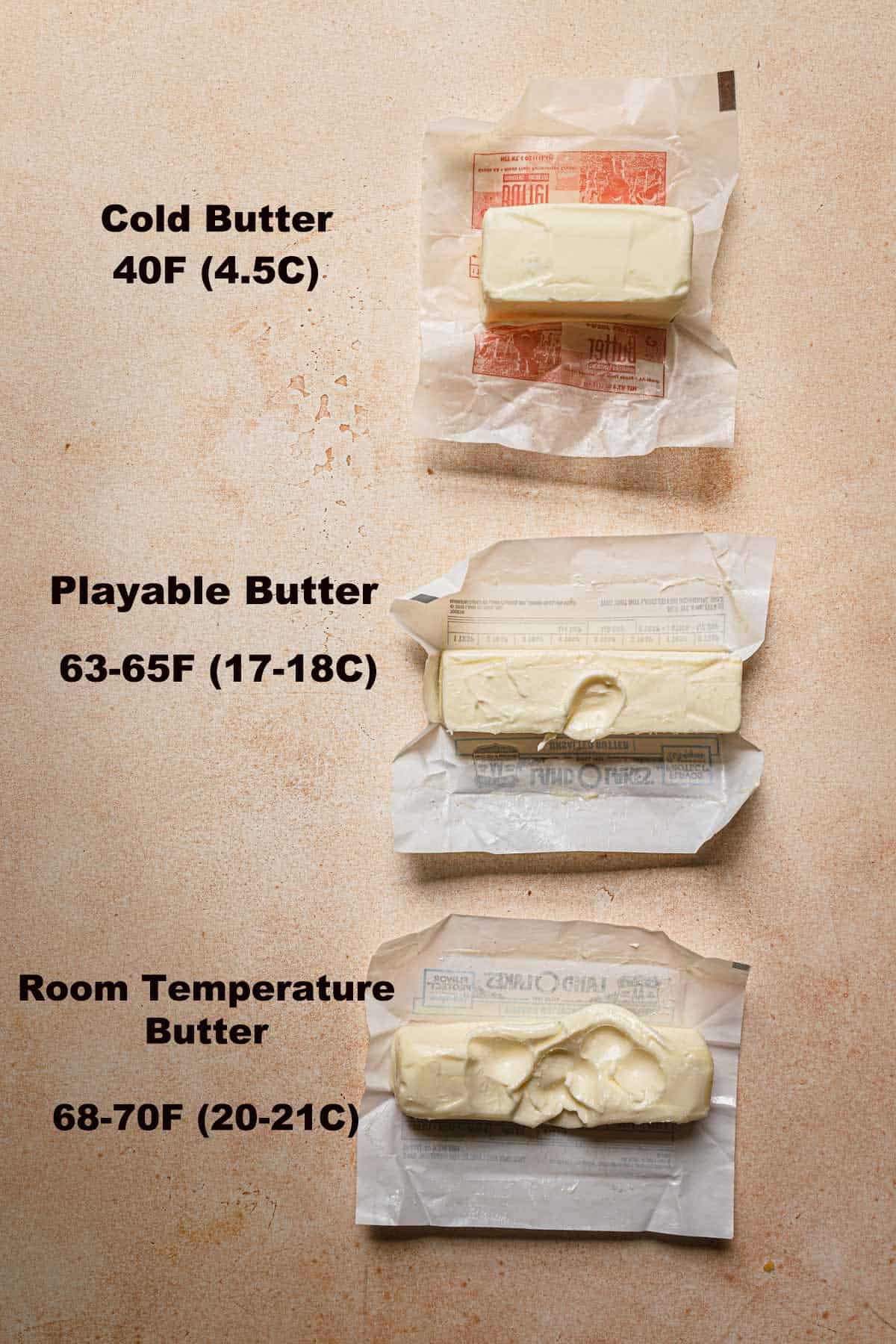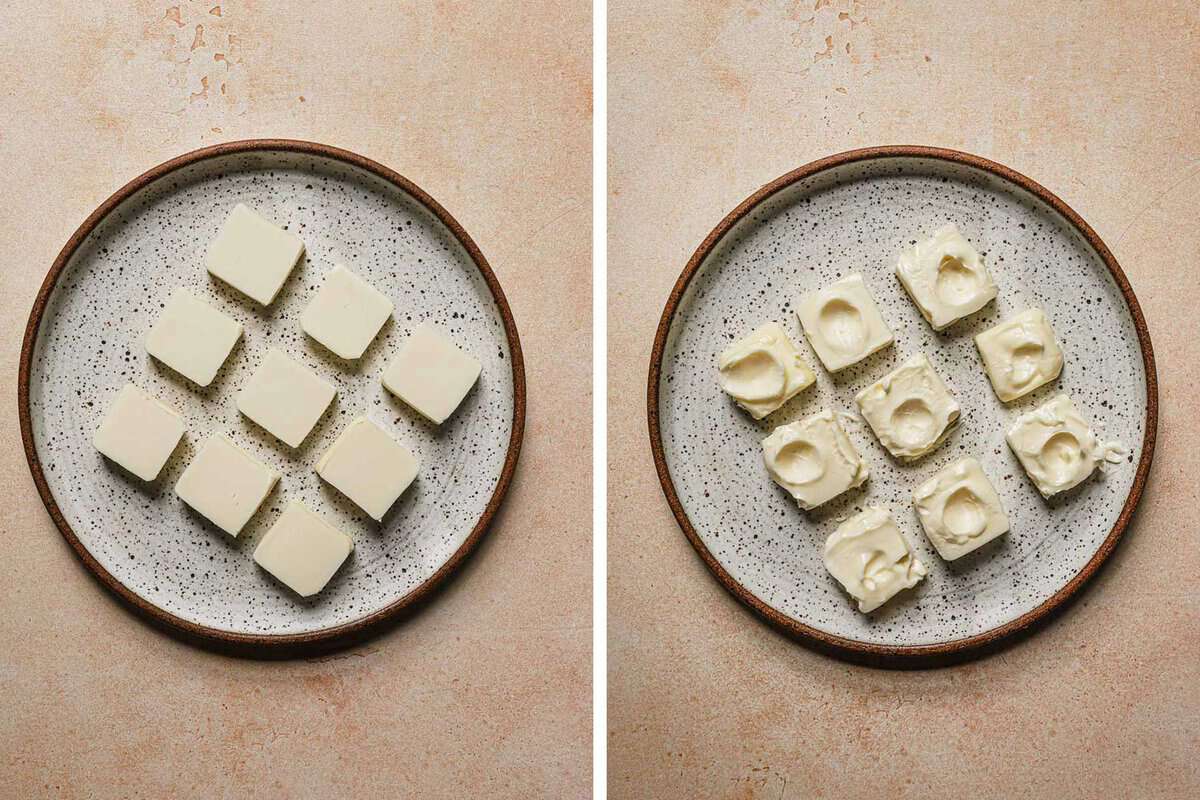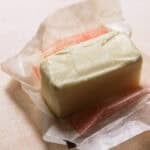Last updated on September 6th, 2024.
Soft butter is a staple ingredient in many recipes, from baking cookies to spreading on toast. But what do you do when you need softened butter in a pinch? Whether you forgot to take it out of the fridge ahead of time or need it softened quickly, this is how to soften butter fast.

What is Soft Butter
Soft butter refers to butter brought to room temperature, making it easy to spread or incorporate into recipes. Like room temperature eggs, It blends more smoothly into batters and doughs, resulting in a more uniform texture in baked goods. Here are the four phases of butter in baking:
Room-temperature butter: When it reaches 68-70F (20-21C), it is easy to press/cut and has a spreadable consistency, and it leaves a dent when you press it with your fingers. It’s easy to cut and incorporates other ingredients, such as sugar, and it’s crucial for baking pound cakes like this Almond Cake and this Italian Hangover Cake.
Cold butter: A cold stick of butter from the refrigerator is at about 40F (4.5C); it holds its shape and its 12-15% water content. (perfect for pie crust and scones because the water is “trapped” and does not bond with the flour, and creates strong gluten chains)
Playable butter: When it reaches 63-65F (17-18C), it’s the best of both worlds. It’s easy to manipulate; you can cut it easily, but it still holds its water percentage, and it does not incorporate as easily with other ingredients. It leaves a dent when you press it with your fingers, but mostly on the surface. Great for making cookies in the food processor, like these Hazelnut Shortbread Cookies.
Melted Butter: when we heat butter over 90F (32C), the fat reaches its melting point and changes from solid to liquid. When that happens, the water in it becomes loose and will easily be incorporated into other ingredients. (great for soft and chewy chocolate chip cookies).

Why is Soft Butter Important
In my book Baking Science, a whole chapter is dedicated to the importance of temperature in baking. I also discuss the temperature of butter and why it is so important.
Soft butter is crucial in baking because it affects the texture and structure of your baked goods. If you try to cream it cold with sugar, it won’t mix evenly, leading to clumps and uneven texture in your final product. Soft butter ensures that your ingredients blend seamlessly, resulting in light, fluffy cakes, cookies, and pastries.
When a recipe calls for room temperature butter, don’t use cold or melted butter; in many cases, the wrong temperature of the butter (as well as the rest of the ingredients) is why so many recipes fail and we end up with dense cakes, flat cookies, and more.
How to Soften Butter Fast
If I am honest, the best way to ensure you have the proper room-temperature butter is to plan and place it over the kitchen counter about 60-90 minutes ahead of time. The time might differ depending on where you live, the weather, the season, and the humidity in your kitchen.
Alas, life happens when you make baking plans, and more often than not, the softening process needs to be shortened.
Below are four different and simple methods to soften butter, arranged by the fastest (5-10 seconds) to the longest (20-30 minutes). It took me a while to figure out which method works best for me, and I recommend trying each method and deciding which works best for you.
Microwave method, option one
- Cut the butter into 1/2-inch chunks to ensure even softening.
- Place it on a microwave-safe plate or dish in a single layer.
- Microwave in 5-7 seconds short bursts, checking after each interval.
- Once softened, let it sit for a minute or two before using.

Using the Microwave, option two
This is my favorite method; there are no preparations. Note that to reach the perfect consistency, it needs another 10-20 minutes on the counter.
- Place the cold butter wrapped in the microwave and heat for 5-7 seconds.
- Check the consistency; if it is still very cold, give it another burst of 5 seconds.
- Make sure to turn it over between each burst. Once it is slightly soft (and mostly at the surface area), stop.
- Remove from the microwave and let it sit at room temperature for 10-20 minutes.
Using a Glass Cup or A Bowl
Use a cup for one stick of butter (1/2 cup) or a bowl for one cup or more. For an amount greater than one cup, use a box grater to shred the hard butter or cut it into small cubes.
- Fill a large glass with boiling water and let it sit for a minute to warm up.
- Pour out the water and dry the glass.
- Place the glass upside down over the entire stick of butter.
- The residual heat trapped inside the warm glass will soften it within minutes.

Use Indirect Heat
I like to use this method when I have some time on my hands (about 20-30 minutes), my oven is baking, or my dishwasher is working. When using this method, it is essential not to unwrap, cut, or use a rolling pin to flatten the butter.
- Place the cold butter over a baking dish. Place the baking dish over the stovetop, and make sure to turn it every 5-7 minutes. (or place the butter over the counter above the dishwasher as it works)
- The indirect heat will gradually soften the butter without melting it.
Tips
- Avoid using high-heat methods like direct stovetop heat or as it can cause uneven softening or melting.
- If you accidentally melt the butter, you can salvage it by placing it back in the fridge to firm up before using it in your recipe.
- Always plan a head, when baking, shortcuts are great, but don’t confuse them to a baking technique. Baking is a very delicate process that calls for precision, and accuracy.
- Cream cheese is not butter, so I do not recommend using these method to bring cream cheese to room temperature.
Here are more how-to recipes you might like
How To Temper Chocolate, How to Stabilize Whipped Cream, How To Make Meringue.
How To Soften Butter Fast
Ingredients
- 1 Cup Boiling water (for method 3) (240ml)
- 1/2 Cup Cold butter (113g)
Instructions
Using the microwave, option one
- Cut the butter into 1/2-inch chunks and arrange them over a microwave-safe plate.
- Microwave the butter twice for 5-7 seconds for each burst.
- Let the butter sit for a few minutes and allow it to soften some more from the heat residue coming from the warm parts of each piece. Use your fingers to check for softness.
Using the Microwave, second options
- Microwave the butter with its wrapping twice for 7-10 seconds, turning the butter over between each burst (depending on the strength of your microwave).
- Gently press the butter; it should feel soft, mostly on the surface. If still cold, microwave it for another 7-10 seconds.
- Place the butter on your kitchen counter for about 10-20 minutes to completely soften.
Using a glass cup
- Fill a glass cup slightly taller than your butter with boiling water and let sit for 2-3 minutes.
- Pour out the water, and top the cup upside-down over the butter stick.
- Allow the butter to soften from the cup's warmth for about 10 minutes.
Using Heat Residue
- Place the butter in close proximity to a warm spot in your kitchen, next to your stovetop, on top of a baking over, or over your working dishwasher.
- Make sure to check every 5-10 minutes and turn sides if necessary.
Notes
- Avoid using high-heat methods like direct stovetop heat as it can cause uneven softening or melting.
- If you accidentally melt the butter, you can salvage it by placing it back in the fridge to firm up before using it in your recipe.
- Always plan ahead when baking. While shortcuts are great, don’t confuse them with a baking technique. Baking is a very delicate process that calls for precision and accuracy.
- Cream cheese is not butter, so I do not recommend using these methods to bring it to room temperature.
- Use a cup for one stick of butter (1/2 cup), or a bowl for one cup or more. For an amount greater than one cup, use a box grater to shred the hard butter, or cut it into small cubes.


